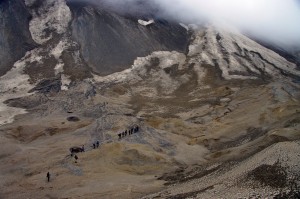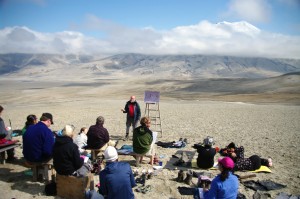2012 International Volcanological Field School begins
May 31, 2012

Amy Hartley
907-474-5823
5/31/12
On the centennial of the Novarupta eruption – a cataclysmic event that created the Valley of Ten Thousand Smokes in southwest Alaska – a group of 19 students and scientists will embark on the summer’s first hike to the massive volcano.
The group is participating in the 2012 International Volcanological Field School, a two-week volcanology field class in Katmai National Park that kicks off June 3.
Students will learn about volcanology in a hands-on, extreme context, exploring key sites in the Valley of Ten Thousand Smokes, the locale of two of the largest volcanic eruptions of the last century. The experience is unique and takes a tremendous amount of planning and preparation, according to Pavel Izbekov, a research associate with the Alaska Volcano Observatory at the University of Alaska Fairbanks Geophysical Institute. Izbekov is leading the field school with John Eichelberger, U.S. Geological Survey volcano hazards program coordinator.
“The hardest task is to explain what students are in store for,” Izbekov said amid three ActionPacker storage containers, four large packs and various other supplies stacked in his office. “It’s cold and it’s quite rugged. I tell them when I write ‘strenuous’ (in an email), I mean it.”
Students will participate in lectures, study key geological sites and work in groups, traversing Katmai National Park, hiking as much as 20 miles a day, while carrying packs with all of their gear.
Izbekov, a graduate from UAF, has coordinated the annual field school since 2003.
He says he enjoys the annual expeditions and the transformation students, both graduate and undergraduate, undergo as part of the program.
“It’s very important for geologists to travel, to see things with our own eyes,” he said. “The field school provides strong motivation for students to continue their careers in geosciences and that’s our primary goal.”

The 2012 International Volcanological Field School has two sessions. The first session takes place in Katmai, while another two-week session runs from Aug. 2 – 16, 2012 in Kamchatka, Russia. The program is funded completely by student course fees and is hosted by the UAF Department of Geology and Geophysics in cooperation with the Institute of Volcanology and Seismology and the Kamchatka State University in Petropavlovsk-Kamchatsky, Russia.
More than 350 students have participated in the program since its inception.
ADDITIONAL CONTACTS: Pavel Izbekov, research associate at AVO/GI, at 907-474-5269 or via email at pavel@gi.alaska.edu.
ON THE WEB: Department of Geosciences
NOTE TO EDITORS: Izbekov leaves for the field this weekend, but is available for in-person interviews this afternoon and Friday.
AH/5-31-12/259-12


